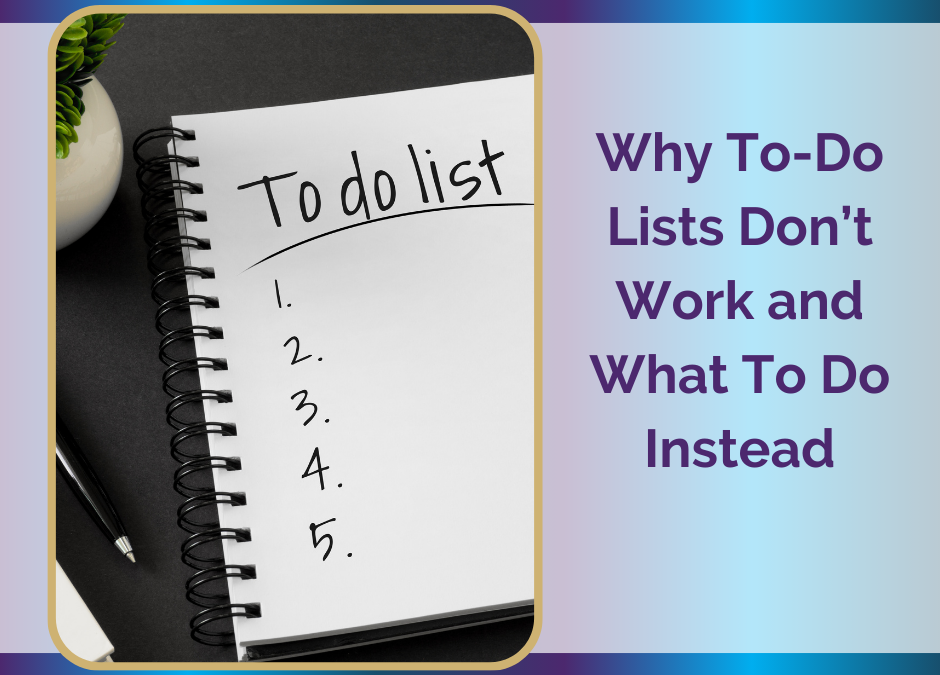Let’s be honest. Most of us have scribbled a to-do list on a multitude of Post-it notes, typed one into our phones, or made a colour-coded masterpiece with highlighters and bullet points. It feels productive. Organised. Like we’ve got our life sorted.
But give it a few hours – or days – and there’s that familiar sense of guilt creeping in. The list is still there, half-finished, glaring at us like a judgemental old aunt. We end up overwhelmed, paralysed, or procrastinating with tasks that weren’t even on the list. So, what’s going wrong?
Here’s the thing: to-do lists are seductive, but they’re rarely effective. At least, not on their own.
The Myth of Productivity
The problem with traditional to-do lists is they trick us into thinking we’re being productive when we’re really just keeping busy. Most lists are nothing more than a brain dump. They lack nuance, prioritisation, and any sense of how long things actually take. They’re a collection of ‘shoulds’, pulled from thin air and stuck on paper without context.
Worse, they’re static. Life isn’t. You wake up with good intentions, then the phone rings, your kid throws up, your Wi-Fi drops out, and suddenly the list isn’t relevant anymore. But it’s still sitting there, demanding your attention and making you feel like a failure.
That pressure isn’t just annoying – it’s exhausting. And it can lead to decision fatigue, which basically means you’ve got no mental energy left to choose what matters. What moves you forward through business, let alone your everyday? So, you default to easy wins – crossing off minor tasks for the dopamine hit – while the stuff that actually matters keeps getting pushed back.
The “Urgent vs Important” Trap
Another classic trap is mistaking urgency for importance. A to-do list with twenty (20) items doesn’t distinguish between ‘reply to that email’ and ‘start the project that could change your business.’ Urgent tasks shout the loudest – and we respond to the noise. Cue the age-old idiom, ‘The squeaky wheel gets the grease.’ But important tasks require space, focus, and intention. And they rarely get a fair go on a traditional list.
So, what do we do instead?
It’s not about ditching the list entirely. It’s about transforming the way we plan, focus, and take action. Let’s break it down.
- Start With Intent, Not Tasks
Before writing anything down, ask yourself: What matters most today? What outcome do I want by the end of this week? What will move the needle in my life or business?
That simple reframe takes you from reacting to your day to leading it.
Intent is the compass. Tasks are just the map. - Chunk Your Energy, Not Just Your Time
You’re not a robot ticking off boxes. You’re a human being with limited energy. Instead of assigning random tasks throughout your day, group them based on the kind of energy they need.
High-focus stuff – like writing, strategising and solving problems – needs uninterrupted, brain-on-deck time. Low-focus stuff – emails, admin, errands – can live together in another block. And if you’re tired or flat, build in time buffers. Let’s not forget that rest is productive, too. - Use a Priority Grid
Try this simple framework, popularised by Eisenhower but updated for real life:
Category Example
Important & Urgent Crisis, deadlines
Important & Not Urgent Strategic planning, learning
Urgent & Not Important Emails, most meetings
Not Urgent & Not Important Mindless scrolling, busywork
Start your day with the top two categories. Be ruthless about saying no to the bottom ones. You’ll reclaim a stack of time.
Note: If you would like to read more about the Eisenhower Matrix, you can read my article about the popular time management method here. - Focus on Outcomes, Not Actions
Instead of listing ten (10) individual tasks, group them under a shared outcome.
For example:
• Outcome: Launch new offer
• Tasks: Write landing page, set up payment link, email list
Now your brain knows why you’re doing what you’re doing. That clarity builds momentum. - Build a Rhythm, Not Just a Routine
Life happens. Dogs bark, phones ring, and moods swing. So, your system needs flexibility.
Instead of rigid routines, build rhythms. Maybe Mondays are creative days. Tuesdays are for outreach. Fridays are catch-up or coast days. This helps your brain anticipate what’s coming and slide into gear.
Rhythms are sustainable. Routines often fall apart at the first curveball. - Make Peace with Incompletion
Here’s the wild truth: no one ever gets everything done.
And that’s not a failure. It’s life.
Instead of beating yourself up, ask, What did I learn today? What did I move forward? What matters most tomorrow?
Progress beats perfection. Always.
So, back to the big question. Do to-do lists work? Not really – not if they’re cluttered, rigid, and disconnected from your values. But when you shift from task-oriented to intentional, energy-smart planning, you stop chasing productivity and start building momentum. That’s where the magic is. In clarity, focus, and aligned action. Not a list that looks pretty on paper but makes you feel crummy by day end.
Now, go make a plan that loves you back.
Connect With Me:
If you are a coach or a consultant and need executive support help to uplevel your business administration and support, reach out and let’s start a discussion about how we may partner in business and get your schedule and background processes humming.
Book a free chat with me here.

